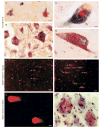DNA damage and repair: relevance to mechanisms of neurodegeneration
- PMID: 18431258
- PMCID: PMC2474726
- DOI: 10.1097/NEN.0b013e31816ff780
DNA damage and repair: relevance to mechanisms of neurodegeneration
Abstract
DNA damage is a form of cell stress and injury that has been implicated in the pathogenesis of many neurologic disorders, including amyotrophic lateral sclerosis, Alzheimer disease, Down syndrome, Parkinson disease, cerebral ischemia, and head trauma. However, most data reveal only associations, and the role for DNA damage in direct mechanisms of neurodegeneration is vague with respect to being a definitive upstream cause of neuron cell death, rather than a consequence of the degeneration. Although neurons seem inclined to develop DNA damage during oxidative stress, most of the existing work on DNA damage and repair mechanisms has been done in the context of cancer biology using cycling nonneuronal cells but not nondividing (i.e. postmitotic) neurons. Nevertheless, the identification of mutations in genes that encode proteins that function in DNA repair and DNA damage response in human hereditary DNA repair deficiency syndromes and ataxic disorders is establishing a mechanistic precedent that clearly links DNA damage and DNA repair abnormalities with progressive neurodegeneration. This review summarizes DNA damage and repair mechanisms and their potential relevance to the evolution of degeneration in postmitotic neurons.
Figures

References
-
- Lindahl T. Instability and decay of the primary structure of DNA. Nature. 1993;362:709–15. - PubMed
-
- Cleaver JE. Defective DNA repair replication in xeroderma pigmentosum. Nature. 1968;218:652–56. - PubMed
-
- Ronen A, Glickman BE. Human DNA repair genes. Environ Mol Mutagen. 2001;37:241–83. - PubMed
-
- Brooks PJ. DNA repair in neural cells: Basic science and clinical implications. Mutat Res. 2002;509:93–108. - PubMed
Publication types
MeSH terms
Substances
Grants and funding
LinkOut - more resources
Full Text Sources
Other Literature Sources

